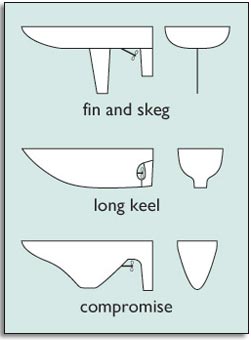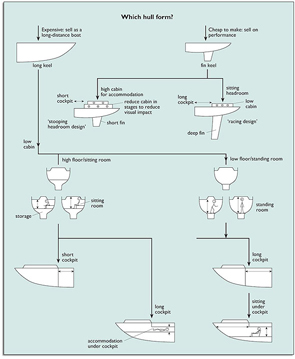4 Conceptual design
4.2 Conceptual design in sailing boat hulls
Hull shapes for sailing boats typically fall into the three types shown in Figure 22. The ‘fin and skeg’ design is typical of modern mass-produced yachts and small dinghies. The long-keel design is typical of working boats designed to be handled by a small crew. These two forms represent extremes of stability and performance. The dish shaped hull of the fin-and-skeg will skate on the sea's surface and turn quickly, whereas the long-keel yacht will be stable in a rough sea and manoeuvre slowly enough for a small crew to have time to handle sails and ropes. The compromise design is typical of a 1950s yacht. It has better turning performance than the long-keel design and more stability than the fin-and-skeg design.
Many large, modern sailing boats, designed and made for both cruising and racing, have the same overall form as small dinghies. These dinghy shapes are cheap to manufacture, lively, quick, and none too comfortable. You might imagine that they are advertised for speed rather than ease and cheapness of manufacture.
The sketch of three hull forms shows no superstructure (cabins etc.) on the hulls. Clearly somewhere must be provided for the crew to eat and sleep, for storage of sails and equipment etc. Depending on the design of the hull of the yacht, there will be different available solution spaces.
There is a clear compromise between sailing performance and interior space that a designer must consider. Anyone sailing on the boat will need to have headroom. This can be achieved either by building up from the deck level of the keel – which introduces surfaces that are exposed to the wind and affects the sailing properties – or by situating the living space inside the keel itself. If a fin-and-skeg design is chosen the only way to provide headroom is to build upwards, whereas a long-keel design can provide headroom inside the hull. Whether the headroom that is required is for standing or sitting extends the problem. A large, high cabin to maximise the interior space and carry people in well-lit comfort is a common design solution for modern pleasure yachts that are unlikely to be used in difficult conditions.
Consider now, how space might be subdivided in the two extremes of fin-and-skeg design and long-keel design. A decision tree can be created to show the different design solutions, Figure 23. (Note that for simplicity the fin-and-skeg design is shown simply as a finned keel.)
The design decisions concerning how space is apportioned as the design progresses are shown as a hierarchy. Clearly, the choice between a shallow hull with a fin keel and a deep hull with a long keel is a high-level decision that imposes significant constraints on the decisions that follow. The next choice, between a low and a high cabin, on the fin–keel branch of the tree, will lead to very different designs of yacht. The long cockpit, for easy sail handling, naturally goes with a low cabin, for reduced wind resistance, on a racing design. Going for the high-cabin option creates a design where interior accommodation is more important than performance, and a shorter cockpit gives more length in the cabin to split up the space between cooking facilities, lavatories and bunks. It is unlikely that the buyer of a high-cabin boat will want a large cockpit. The low cabin design will give interior space for a sitting person, but not for a standing or a stooping person.
With a long-keel design (top left of Figure 23), the extra depth in the hull means that a high superstructure is not required, so the first decision shown is a choice between a high (and therefore wide) floor, giving sitting room, and a low floor, giving standing room. The compromise here is to accept sitting room as a price worth paying for a large floor area that gives more freedom to arrange tables, beds, sinks, lockers and chairs in different ways.
A variable more significant in the high-floor design is the width of the cabin superstructure. A wide cabin gives narrow side decks that inhibit working above deck but might give more headroom inside the yacht. A design where a person can sit underneath a side deck gives a very different use of space than a design where sitting is only possible under the cabin roof.
A further branching of the tree is shown on the basis of a decision about the length of the cockpit and how the room underneath the cockpit floor is used. Shown are two design solutions that show sitting and lying room underneath. Clearly another solution is to have no interior space under the cockpit floor, but to use it all for lockers accessible from the outside. These might be used to store sails and rope.
From this decision tree it can be seen that the design choices about geometry are connected and hierarchical. Also the choices can be made from their implications on the performance of the yacht, without having to model the detail of the aerodynamic and hydrodynamic principles which govern the yacht's performance.
The route taken through this maze of interlinked decisions can lead to yachts of very different types and functionalities.
SAQ 10
How does the initial choice of fin-and-skeg or long-keel design for the hull influence the provision of a superstructure for accommodation?
Answer
The long-keel design has more available space within the keel, so it is not necessary to build as large a superstructure on the deck. For equal available space, a fin-and-skeg design requires more superstructure to be built above the level of the deck.
In the next section, two different design solution spaces are going to be evaluated with the help of some simple formulae.


